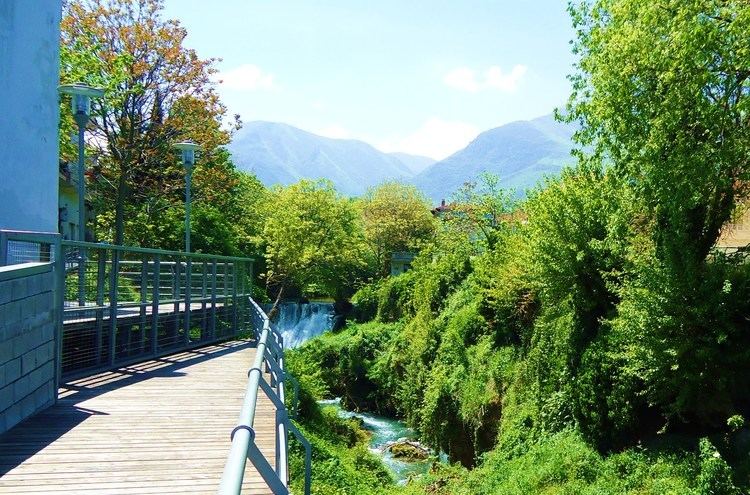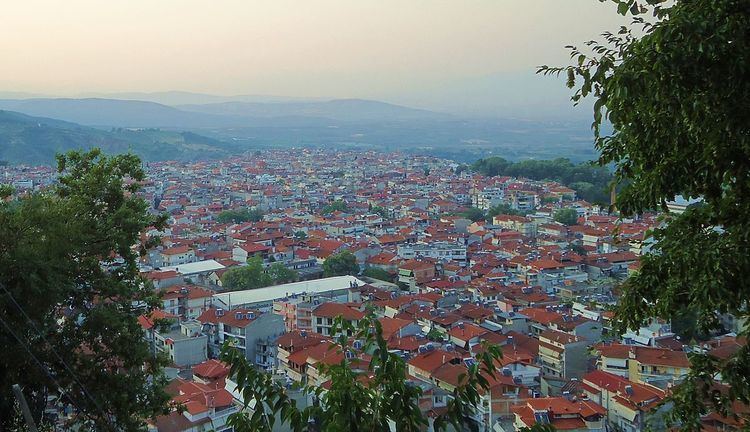Country Area 424.9 km2 | Elevation 363 m | |
 | ||
Map of Naousa, Imathia
Naousa (Greek: Νάουσα, historically Νάουσσα - Naoussa), officially The Heroic City of Naousa is a city in the Imathia regional unit of Macedonia, Greece with a population of 18,882 (2011). An industrial center since the 19th century, for most of the 20th century the history of Naousa was closely intertwined with that of the Lanaras family, local industrialists who, at the height of their influence, employed almost half of Naousa's population in their textile factories. The Lanaras family built hospitals, social centers etc. while streets of Naousa were named after family members. In the 1990s and 2000s however, most of the local factories closed, leaving Naousa with a serious (and still unresolved) unemployment problem.
Contents
- Map of Naousa Imathia
- Hotel vermion naousa imathias greece
- Agios nikolaos naousa imathia greece fishing lake
- Municipality
- Province
- History
- Geography
- Climate
- Sports
- Twin towns Sister cities
- Notable people
- References

Hotel vermion naousa imathias greece
Agios nikolaos naousa imathia greece fishing lake
Municipality

The municipality Naousa was formed at the 2011 local government reform by the merger of the following 3 former municipalities, that became municipal units:

The municipality has an area of 425.491 km2, the municipal unit 300.891 km2.
Province
The province of Naousa (Greek: Επαρχία Νάουσας) was one of the provinces of Imathia. It had the same territory as the present municipality. It was abolished in 2006.
History
The city is situated in ancient Emathia west of the ancient Macedonian town of Mieza and the site of ancient School of Aristotle. The area, according to Herodotus, was where the fertile Gardens of King Midas were situated. Later, in the current position of the city, the Romans established the colony of Nova Augusta. The name changed through the centuries to Niagusta, Niaousta and Niaousa, until it became today's Naousa. It was known as "Ağustos" during Ottoman rule.
In 1705, an armatolos named Zisis Karademos led a Greek uprising against the local Ottoman garrison.
In 1822, during the Greek War of Independence, the fighting in Central Macedonia against the Turks came to a dramatic finale in Naousa. Abdul Abud, the Pasha of Thessaloniki, arrived on 14 March at the head of a 16,000 strong force and 12 cannons. The Greeks defended Naousa with a force of 4,000 under Anastasios Karatasos, Dimitrios Karatasos, Aggelis Gatsos, Karamitsos and Philippos, the son of Zafeirakis Theodosiou, under the overall command of Zafeirakis Theodosiou and Anastasios Karatasos. The Turks attempted to take the town of Naousa on 16 March, and again on 18 and 19 March, without success. On 24 March the Turks began a bombardment of the city walls that lasted for several days. After requests for the town's surrender were dismissed by the Greeks, the Turks charged the Gate of St George on Good Friday, 31 March. The Turkish attack failed but on 6 April, after receiving fresh reinforcements of some 3,000 men, the Turkish army finally overcame the Greek resistance and entered the city. In an infamous incident, as the rebels were abandoning the town, some of the women left behind committed suicide by falling down a cliff over the small river Arapitsa. Zafeirakis Theodosiou was pursued by a Turkish unit and was killed. The other Greek leaders retreated southwards. Abdul Abud laid the town and surrounding area to waste. The fall and massacre of Naousa marked the end of the Greek Revolution in Central Macedonia.
Naousa has a large population of Aromanians, also known as Vlachs, and a small Romani population.
Geography
Naousa is located in Northwestern Imathia, 22 kilometers north of Veroia and 90 kilometers east of Thessaloniki, the biggest city in Northern Greece. The city lies on the eastern foothills of Vermio Mountains, one of the biggest mountain ranges in Greece, and west to the plain of Kambania (or Giannitsa). Naousa is today the largest forest-owning municipality in the country being also surrounded by orchards, producing peaches, apples, cherries and other fruits, while the jam brand name Naousa is well-known all over Greece. Naousa is also known for its parks (Municipal Park, Park of Saint Nicholas etc.) and for its ski resorts (3-5 Pigadia and Seli). Due to its location, altitude can raise by as much as 150m between the lowest and highest parts of the city, and it reaches nearly 550m in the Park of Saint Nicholas. Naousa is also home of one of the three female named Greek rivers, Arapitsa, together with Neda in Peloponnesus and Erkyna in Livadia.
Climate
Naousa has a humid subtropical climate (Cfa) in the Köppen climate classification but due to its inland location and elevation, is more continental (and less Mediterranean) than that found in most Greek cities. It is heavily influenced by the mountains which rise rapidly up to the west, and by the plain of Kambania to the east. On one hand, the mountains shelter the area from cold winds blowing from the north and west down the Balkan Peninsula and also from hot southwest winds, creating a non-extreme microclimate. On the other they create föhn winds, which draw in cool, damp air from the Aegean coast. The annual precipitation of Naousa is typically lower than in western Greece, but it is one of the highest in the Macedonia region, measuring around 710 mm per year. Winters can be cold and Vermio mountains are home to two of the most famous skiing resorts in Greece, Seli and 3-5 Pigadia. In the city, snowfall is quite common and measurable amounts of snow can remain on the ground for several days. Typically, downtown Naousa experiences milder winter temperatures than the suburbs where temperatures can drop many degrees below zero. Recent years have been a lot warmer and the 2007 European heat wave saw Naousa reaching 40°C for the first time in recent memory, with an absolute maximum of 41.3°C in July 25th. In January 8th, 2017, temperature dropped to -10.5°C, which is a 10-year low.
Sports
Skiing club EOS Naousas is the oldest of the city's sporting clubs, having been founded in 1932. Naoussa also hosts the clubs Naoussa F.C., which played at First National Division of Greece for one year (season 1993-94) and EGS Zafeirakis Naousas (Greek: Ε.Γ.Σ.Ζαφειράκης Νάουσας) that competes at volleyball, handball and basketball. The name refers to the Greek prokritos Zafeirakis Theodosiou (Greek: Ζαφειράκης Θεοδοσίου) (1772–1822).
Twin towns — Sister cities
Naousa, Imathia is twinned with:
